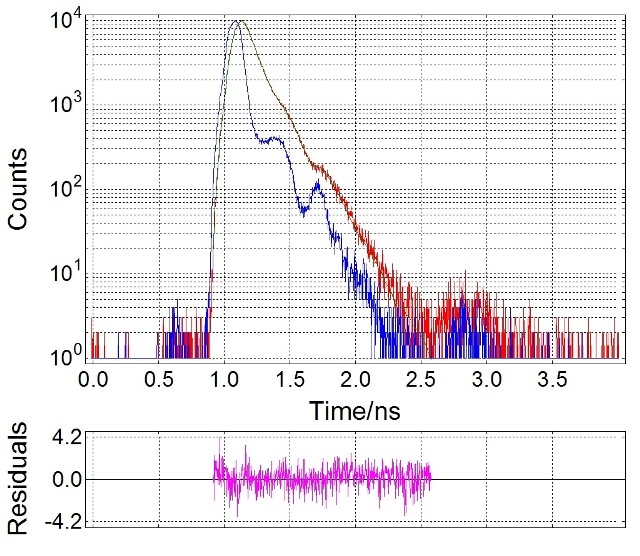The LifeSpec II is a compact, fully integrated, high performance fluorescence lifetime spectrometer.
It is designed for use with high-repetition rate pulsed femtosecond and picosecond lasers. The system is a fully automated solution, incorporating software and hardware in a single package for fundamental research and routine laboratory applications.
Its zero temporal dispersion optics set the standards for technical performance in measuring ultra-fast decays.
The LifeSpec II uses the method of Time Correlated Single Photon Counting (TCSPC) for accurate measurements of fluorescence lifetimes. The LifeSpec II features a subtractive double monochromator, giving the spectrometer zero temporal dispersion and allowing the instrument to measure fluorescence lifetimes down to 5 ps – 10 ps.
Advanced software analyzes the raw data and controls all of the hardware. With reconvolution, the software can reliably measure fluorescence lifetimes down to a tenth of the instrument response function.
Data acquisition modes range from time-resolved spectra and fluorescence lifetime decay acquisitions to automated time-resolved anisotropy measurements and automated temperature maps.
The LifeSpec II in the standard configuration is supplied with one detector, but additional detectors can be added. The LifeSpec II requires at least one picosecond pulsed diode laser, pulsed LED, supercontinuum laser or Ti:Sapphire laser (with appropriate pulse picker) for operation.

Sample Chamber
A variety of sample holders can be fitted easily to the LifeSpec II due to it's large sample chamber. These include multiple sample holders, single cuvette holders, front face film/bulk/powder holders, thermostated sample holders, fiber attachments, and cryostats.
Subtractive Double Monochromator
Zero temporal dispersion in the optical path is a requirement for precise measurements in the lower picosecond time scale. Conventional monochromators introduce temporal shifts and pulse broadening originating from propagation delays caused by the dimensions of the grating.
The new design of the LifeSpec II uses two coupled monochromators with opposite pulse broadening features. This removes temporal dispersion and temporal delays and improves the stray light rejection. In this manner, sources of errors in the response of the instrument are reduced and lifetime measurements can be performed and analyzed more precisely.
Computer Controlled Polarizers
Computer Controlled Polarizers Motorized mounts are used both in the emission path and in the excitation beam path to operate the optional Glan Thompson polarizers. An excitation polarizer may not be required if the laser’s emission is naturally polarized, which is the case for picosecond-pulsed diode and Ti:Sapphire lasers.
Linearly polarized excitation and emission are required for fluorescence anisotropy measurements. However, even for precise fluorescence decays (energy relaxation), polarizers may be needed to remove rotational artifacts that are superimposed on the fluorescence decay (“magic angle” measurements).
Download the Brochure for More Information
Measurement and Analysis Capabilities
Data Acquisition Modes
- Time resolved fluorescence spectra
- Fluorescence decay acquisition
- Quasi-steady state spectra (with spectral correction)
- Automated temperature maps (with optional cryostat or Peltier cooled sample holder)
- Automated time-resolved anisotropy measurements (with optional polarisers)
Data Analysis Modes
- 4-exponential fit with background, shift, reconvolution (based on Marquardt Levenberg algorithm)
- Multi-exponential fluorescence anisotropy fits (tail fits only)
Advanced Data Analysis (optional)
- Lifetime distribution analysis with a grid of 200 lifetimes and no a priori shapes of the distribution
- Förster kinetics
- 4-exponential fit with background, shift, reconvolution, no initial guesses required (based on propriety algorithm)
- Global analysis
- Batch analysis
- Micellar quenching fits
- Advanced fluorescence anisotropy kinetics with reconvolution
- Extended expotential components analysis

Principal Layout
The complete LifeSpec II spectrometer consists of the optical spectrometer, a power supple module and a computer fitted with a data acquisition card, the TCC900. In the standard configuration, the LifeSpec II is fitted with a single selected light source and a single detector.
The system can be upgraded with additional sources, sample cooling stages, detectors, polarizers, and fiber optics. Some of these upgrades have to be factory fitted.
The LifeSpec II main unit is height adjustable so that the optical plane can be fixed between 130 mm and 180 mm from the table top. This simplifies beam steering and coupling of complex external laser systems to the LifeSpec II.
Light Sources and Detectors
The LifeSpec II spectrometer can be used with all advanced high repetition rate pulsed sources, such as picosecond pulsed diode lasers and LEDs, femtosecond Ti:Sapphire lasers, and supercontinuum “white” picosecond pulsed lasers.
The standard LifeSpec II comes with an adjustable receptor flange for picosecond pulsed diode lasers (EPL Series) and UV-LEDs (EPLED Series). A supercontinuum laser can be fitted with a special wavelength selection package that allows computer controlled wavelength and spectral bandwidth selection. This package also has an incorporated and optimized laser synchronization trigger pick-up.
Alternatively, radiation of Ti:Sapphire lasers with pulse picker and frequency doubling/tripling can be used for sample excitation. A trigger pick-up accessory is available.
The shortest measurable lifetime depends on the speed of the detector and on the pulse width of the picosecond pulsed light source. By applying numerical reconvolution, lifetimes as short as 1/10th of the system’s instrumental response function can be extracted from the data.
Download the Brochure for More Information